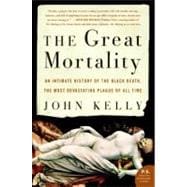John Kelly tracks the medieval plague from its beginnings in Central Asia to its devastating impact on the teeming cities of Europe, painting a vivid picture of what the end of the world looked like in the 14th century.
La moria grandissima began its terrible journey across the European and Asian continents in 1347, leaving unimaginable devastation in its wake. Five years later, twenty-five million people were dead, felled by the scourge that would come to be called the Black Death.
The Great Mortality is the extraordinary epic account of the worst natural disaster in European history -- a drama of courage, cowardice, misery, madness, and sacrifice that brilliantly illuminates humankind's darkest days when an old world ended and a new world was born.
The book's strengths are its discussion of recent scholarship on both the origin and the nature of the plague. It is a gripping story of a most horrific and unimaginable event.








